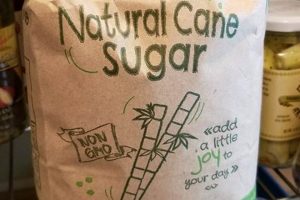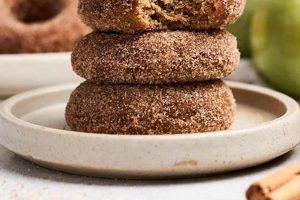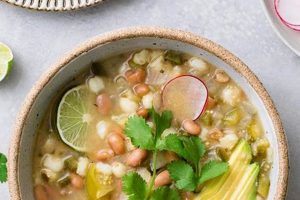The question of whether this popular dessert conforms to a plant-based diet depends entirely on the ingredients used in its preparation. Traditional recipes often incorporate butter and honey, both of which are animal-derived and therefore unsuitable for vegans. Therefore, its inherent composition is not universally plant-based.
Understanding the components of food is critical for individuals adhering to specific dietary guidelines. The widespread appeal of this pastry across cultures highlights the need for transparency regarding ingredient sourcing. Historically, regional variations in recipes have led to diverse preparations, some of which may inadvertently be vegan while others intentionally use non-vegan products to enhance flavor and texture.
Consequently, determining the vegan status requires careful examination of the recipe. Subsequent sections will detail common non-vegan ingredients, explore potential vegan substitutions, and outline how to identify a truly plant-based version of this confection. This thorough analysis empowers consumers to make informed choices aligned with their dietary needs.
Tips for Determining if Baklava is Vegan
Ensuring the absence of animal products requires careful scrutiny of the ingredients and preparation methods. Several key factors should be considered when attempting to determine if this treat is suitable for a plant-based diet.
Tip 1: Request a Detailed Ingredient List: Obtain a comprehensive list of all components directly from the baker or vendor. This is the most reliable way to verify the absence of non-vegan ingredients such as butter or honey.
Tip 2: Inquire About Butter Alternatives: Clarify whether the recipe uses dairy butter or a plant-based substitute like margarine or vegetable oil. Note that some margarines may contain trace amounts of dairy; confirmation is crucial.
Tip 3: Examine the Sweetener: Investigate the type of sweetener used. Honey is a common ingredient, but vegan options such as agave nectar, maple syrup, or sugar can be viable alternatives.
Tip 4: Assess the Phyllo Dough: Phyllo dough should consist solely of flour, water, and a small amount of oil. Confirm that no eggs or dairy have been added to the dough.
Tip 5: Look for Vegan Certifications: When purchasing pre-made baklava, check for vegan certifications on the packaging. These certifications guarantee that the product meets specific vegan standards.
Tip 6: Prepare Baklava at Home: The most certain method involves preparing the dessert at home. This grants complete control over ingredient selection and ensures compliance with dietary preferences.
These strategies empower consumers to make informed decisions, guaranteeing that their consumption of this sweet aligns with plant-based dietary principles.
These factors being clear, the following information contains additional details on how to make vegan baklava from your home.
1. Ingredient awareness
The determination hinges significantly on ingredient awareness. A comprehensive understanding of each component is essential to accurately ascertain its vegan status. Many traditional recipes incorporate butter and honey, substances derived from animals and therefore incompatible with a vegan diet. Without conscious evaluation of the ingredient list, individuals may inadvertently consume non-vegan products, undermining their dietary choices. For example, if a consumer fails to recognize that the phyllo dough contains butter or that honey is used as a sweetener, they will mistakenly assume the dessert is plant-based.
The practical significance of ingredient awareness extends beyond mere identification. It necessitates a deeper understanding of ingredient sourcing and potential alternatives. Bakers sometimes use ambiguous terms, requiring consumers to proactively inquire about the precise nature of the components. Awareness enables informed substitution, such as opting for agave nectar or maple syrup instead of honey or selecting phyllo dough made with vegetable oil rather than butter. Furthermore, it empowers individuals to identify potentially hidden non-vegan ingredients present in seemingly innocuous components.
In summary, ingredient awareness constitutes a fundamental prerequisite for determining dietary suitability. The challenge lies in the potential for ambiguous labeling and variations in traditional recipes. By prioritizing a thorough understanding of ingredients, individuals can navigate these challenges and ensure their choices align with plant-based dietary principles, ultimately contributing to more ethical and informed consumption patterns. This careful scrutiny is a primary safeguard.
2. Butter absence
The exclusion of butter is a pivotal factor when assessing whether a confection aligns with vegan dietary standards. Traditional recipes frequently utilize butter, a dairy product, as a key component. Therefore, the absence of butter directly impacts the classification of the dessert as plant-based.
- Role in Texture and Flavor
Butter contributes significantly to the texture and flavor profile. It imparts richness, flakiness, and a characteristic taste. When formulating a plant-based version, replicating these qualities without dairy requires careful selection of alternative fats. For instance, coconut oil or vegan margarine may be employed, but each will alter the final product’s taste and texture.
- Impact on Phyllo Dough
Phyllo dough, a critical ingredient, is typically brushed with melted butter to create layers and enhance crispness. In a vegan adaptation, the butter must be replaced with a suitable alternative, such as olive oil or vegetable oil. The choice of oil influences the dough’s ability to achieve the desired texture and golden-brown color during baking.
- Recipe Modification Challenges
Successfully omitting butter necessitates adjustments to the overall recipe. The proportion of other ingredients, such as liquids and sweeteners, may require modification to compensate for the absence of fat and moisture that butter provides. Failure to balance the recipe can result in a dry, brittle, or otherwise undesirable outcome.
- Availability of Vegan Alternatives
The feasibility of creating a plant-based version depends on the accessibility and effectiveness of vegan butter substitutes. While various options exist, not all alternatives perform identically to dairy butter. Bakers must experiment to determine the optimal substitute for achieving the desired results in terms of taste, texture, and overall quality. Some vegan butters have a high water content, which can negatively impact the phyllos crispness.
In summary, achieving a confection suitable for a vegan diet necessitates careful attention to the exclusion of butter and the strategic substitution of plant-based alternatives. The challenge lies in replicating the texture and flavor attributes contributed by butter while maintaining the integrity of the traditional recipe. The success of this endeavor significantly influences the overall acceptance and appeal of the final confection.
3. Honey replacement
The substitution of honey is paramount in adapting this pastry for vegan consumption. Traditional recipes invariably incorporate honey as a primary sweetener, rendering them unsuitable for individuals adhering to plant-based dietary guidelines. The replacement of honey is therefore a crucial step in transforming it into a vegan-compliant dessert.
- Alternative Sweeteners: Agave Nectar and Maple Syrup
Agave nectar and maple syrup are common alternatives to honey. These plant-derived sweeteners offer distinct flavor profiles. Agave nectar provides a mild, neutral sweetness, while maple syrup contributes a more pronounced, characteristic flavor. The choice between these alternatives influences the final taste. For example, using maple syrup may impart a more robust and distinct sweetness compared to agave nectar, affecting the overall sensory experience.
- Sugar-Based Syrups and Solutions
Inverted sugar syrups or concentrated sugar solutions represent another category of honey substitutes. These options provide sweetness without the distinctive flavors associated with agave or maple syrup. They consist primarily of sucrose, a sugar extracted from sugar beets or sugar cane. In scenarios where a neutral sweetness is desired, these syrups offer a viable solution. However, their lack of unique flavoring may require the addition of other flavoring agents to achieve a desirable flavor profile.
- Impact on Texture and Moisture
Honey contributes not only sweetness but also moisture and viscosity to the pastry. When substituting honey, it is essential to consider the impact on the desserts texture. Alternatives may have varying levels of viscosity and moisture content, which can affect the overall consistency. Adjustments to other ingredients, such as the amount of liquid or flour, may be necessary to compensate for these differences. For instance, using a less viscous sweetener may necessitate a reduction in other liquid ingredients to prevent a soggy texture.
- Ethical and Environmental Considerations
Beyond dietary compliance, the selection of honey substitutes often reflects ethical and environmental considerations. Honey production raises concerns related to bee welfare and the potential environmental impact of commercial beekeeping practices. Opting for plant-based sweeteners aligns with broader ethical concerns about animal exploitation and environmental sustainability. The choice between agave nectar, maple syrup, or sugar-based syrups may be further influenced by factors such as sourcing practices, processing methods, and carbon footprint.
In conclusion, the successful adaptation for a vegan diet necessitates a carefully considered approach to honey replacement. The choice of sweetener influences not only the taste but also the texture and ethical implications. Thoroughly assessing the attributes of each alternative allows for a more informed decision-making process, resulting in a dessert that aligns with both dietary requirements and broader ethical values. Moreover, attention should be given to sourcing, so that there are no ethical concerns that you might have when selecting your ingredient.
4. Phyllo composition
The composition of phyllo dough directly determines whether can be classified as vegan. Traditional recipes often incorporate non-vegan ingredients, thus making the evaluation of the dough’s constituents paramount. Specifically, the presence of butter or eggs in phyllo dough renders the final product unsuitable for a plant-based diet.
Several commercial phyllo dough products contain butter as a shortening agent, contributing to its flakiness and flavor. Similarly, some recipes include eggs to enhance the dough’s elasticity and structural integrity. For individuals adhering to a vegan lifestyle, identifying these non-vegan elements is critical. The absence of clear labeling necessitates careful scrutiny of ingredient lists or direct inquiry with manufacturers. Alternatively, preparing phyllo dough from scratch using only flour, water, oil, and a small amount of salt ensures complete control over its composition. This approach guarantees compliance with dietary restrictions, allowing for the creation of a truly plant-based confection.
In summary, understanding the intricate relationship between phyllo dough composition and dietary compliance is essential. The presence of butter or eggs fundamentally disqualifies from meeting vegan standards. Vigilant assessment, coupled with either informed purchasing or homemade preparation, enables consumers to confidently align their dessert choices with their dietary principles. Therefore, the phyllo composition is indeed an important point to address the question.
5. Vegan certifications
Vegan certifications serve as a reliable mechanism for verifying whether commercially produced confectioneries, including , adhere to defined vegan standards. These certifications are awarded by independent organizations that scrutinize ingredient sourcing, manufacturing processes, and potential cross-contamination risks. The presence of a vegan certification on packaging provides consumers with assurance that the product is free from animal-derived ingredients. Without such certification, consumers must rely on potentially ambiguous ingredient lists, increasing the risk of inadvertently consuming non-vegan components. For example, the Vegan Action certification logo clearly signifies that the product has been thoroughly assessed and meets strict vegan criteria.
The significance of vegan certifications extends beyond mere ingredient verification. These certifications often encompass broader ethical considerations, such as animal welfare and sustainable sourcing practices. This comprehensive approach aligns with the values of many vegan consumers, who seek products that minimize harm to animals and the environment. For instance, some certification bodies require manufacturers to demonstrate that their suppliers adhere to humane animal treatment protocols, even for ingredients that are not directly animal-derived. This holistic approach promotes transparency and accountability throughout the supply chain, fostering greater consumer trust.
In conclusion, vegan certifications represent a crucial tool for consumers seeking to identify plant-based versions of this dessert. These certifications provide independent verification of vegan status, mitigating the risks associated with ambiguous labeling or potential cross-contamination. By prioritizing certified products, consumers can confidently align their purchasing decisions with their dietary principles and support ethical and sustainable manufacturing practices. The presence of a credible vegan certification greatly simplifies the process of ensuring adherence to a plant-based lifestyle when purchasing this widely consumed pastry.
6. Homemade control
The preparation within a domestic setting provides the ultimate authority over ingredient selection. This direct oversight is particularly pertinent when determining whether the resultant pastry aligns with vegan dietary standards. Through this methodology, adherence to plant-based requirements is not subject to external assurances or potentially ambiguous commercial labeling; rather, it is directly determined by the individual preparing the food.
The preparation method guarantees the exclusion of non-vegan components such as butter and honey, commonly employed in traditional recipes. Plant-based substitutes, including vegetable oils and maple syrup, can be implemented according to specific dietary needs, thereby confirming its appropriateness for vegans. This level of control eliminates risks associated with cross-contamination, a possibility present in commercial establishments where vegan and non-vegan items may be prepared in shared facilities. For instance, if a commercial bakery uses the same equipment for both dairy-containing and vegan items, trace amounts of dairy could inadvertently contaminate the vegan batch. This risk is obviated through preparation.
Therefore, the ability to dictate each ingredient and preparation step is the most reliable strategy for confirming compliance with vegan principles. Though commercial vegan options may exist, preparing the confectionery grants unparalleled certainty. This complete oversight is crucial for individuals with strict dietary requirements, offering a definitive solution to the question of whether this dessert is vegan.
Frequently Asked Questions
This section addresses common inquiries regarding the compatibility of this popular dessert with vegan dietary guidelines, providing clarity and factual information.
Question 1: Does traditional always contain animal products?
Traditional recipes frequently incorporate butter and honey, both of which are animal-derived, making non-vegan by default. However, variations exist, and regional recipes may inadvertently omit these ingredients.
Question 2: What are the most common non-vegan ingredients in ?
Butter, used for layering the phyllo dough, and honey, used as a sweetener, are the most prevalent non-vegan components.
Question 3: Can butter be successfully replaced with vegan alternatives?
Yes, butter can be substituted with plant-based alternatives such as vegan margarine, coconut oil, or olive oil. The choice affects the final texture and flavor.
Question 4: What vegan sweeteners can be used instead of honey?
Agave nectar, maple syrup, and sugar-based syrups are viable vegan alternatives to honey, each imparting a slightly different flavor profile.
Question 5: How can one ensure that phyllo dough is vegan?
Carefully examine the ingredient list for butter, eggs, or dairy. Preparing phyllo dough from scratch, using only flour, water, oil, and salt, guarantees its vegan status.
Question 6: Are vegan-certified commercially available?
Yes, some commercially produced varieties carry vegan certifications, providing assurance that they meet defined vegan standards. Look for recognized vegan certification logos on the packaging.
Determining its vegan suitability hinges on careful ingredient evaluation and conscious selection of plant-based alternatives. Understanding these core points empowers consumers to make informed choices.
The following section explores the historical context of and its adaptations to modern dietary preferences.
Conclusion
This analysis has established that the inherent characteristics of the recipe dictate whether it meets vegan dietary guidelines. Traditional preparations, which commonly include butter and honey, are not compliant. However, strategic substitution of plant-based alternatives, such as vegan margarine and agave nectar, can yield a confectionery that aligns with vegan principles. Furthermore, the composition of phyllo dough and the presence of credible vegan certifications significantly influence the determination of vegan status.
Therefore, a definitive answer to the question of whether is vegan requires thorough investigation and careful selection of ingredients. Consumers must remain vigilant in scrutinizing product labels, inquiring about preparation methods, or opting for homemade versions to ensure adherence to plant-based dietary requirements. The future of this widely enjoyed dessert lies in transparent ingredient sourcing and the continued development of palatable vegan alternatives, thereby expanding its accessibility to individuals with diverse dietary preferences. The vegan status is not inherent, but rather a consequence of conscious and informed ingredient choices.







